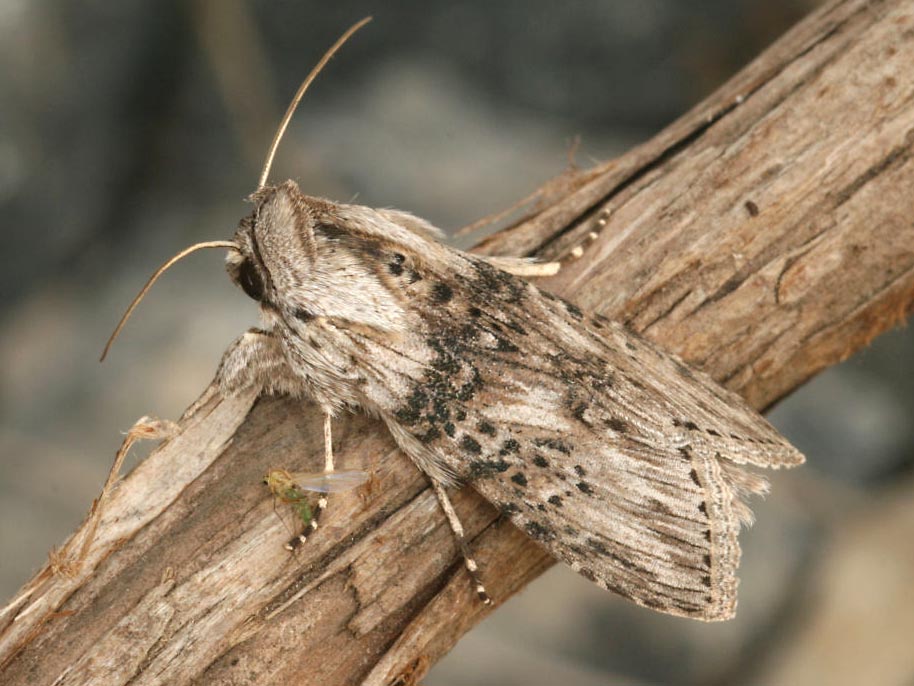Cucullia absinthii
Mugwort Monk ( Cucullia absinthii )
The mugwort Monk ( Cucullia absinthii ), also called wormwood monk, is a butterfly (moth ) from the family of cutworms ( Noctuidae ).
- 6.1 Notes and references
- 6.2 Literature
Features
Butterfly
The moths reach a wingspan of about 35 to 44 millimeters. The fore wings are narrow and of a pale gray to brown-gray ground color. Both the inner and outer cross- line are formed clearly. As a limitation of the fuzzy blemish clear black dots are evident and may be located within the blemish. The midfield is obscured. At the edge of a wedge -shaped black spots highlight. The hind wings are whitish, which turns into a shade of gray to the outside. On the abdomen of the dorsal crest is clearly developed.
Caterpillar
Young caterpillars show a simple green and white striped pattern. In the adult animals thickened, greenish segments are hump -like characteristic, which are equipped with large, crescent-shaped, reddish brown drawing elements. Back, side back and side lines are thin and white in color. The head is mottled with yellow and brown.
Doll
The doll is colored predominantly yellowish, but the elytra greenish shimmer. The cremaster is short and spatulate.
Similar Species
As can be easily distinguished from other kind of Monk, the moths due to the distinctive drawings, the caterpillars can with those of the Silver Monk ( Cucullia argenthea ) be mistaken, but are drawn less defined, particularly since argenthea some dark purple drawing elements has.
Geographic occurrence and habitat
The species is widespread throughout much of Europe and is missing only in the very northern and very southern edge zones. Their eastern extension includes Asia Minor, the Caucasus, northern Iran and extends further to Western Siberia, the Altai Mountains, the Tian Shan massif, here demonstrated in the Ili region, at the Issyk Kul (also Issyk -Kul, Kyrgyzstan ), in the Alexander mountains in Naryn ( Kyrgyzstan ) and Dzharkent (Kazakhstan ) and in Tarbagatai mountains. In the Alps, it rises up to 1600 meters altitude. The mugwort monk is mainly found on sandy soils, so on dry slopes and on Ödländereien and dumps, where the main food plant of the caterpillars ( wormwood ) growing. Occasionally caterpillars have also been found in wormwood planted in gardens.
Way of life
The type is usually one generation per year, flying the moth from late May to early August. Axel Steiner, however, are only the beginning of July to mid-August at the time of flight of moths in Baden- Württemberg. The flight facing moths are crepuscular and nocturnal and are attracted by artificial light sources only a little. They suck nectar. The caterpillars feed mainly on vulgar mugwort (Artemisia vulgaris), wormwood (Artemisia absinthium ) and subordinate also field wormwood (Artemisia campestris ). Younger caterpillars feed initially on the flowers, and later at the fruit stands. Because of their coloring they are well adapted to their environment and thus largely protected from enemies. They pupate in the soil in the fall, where the dolls are sometimes over two years.
Endangering
In most of its distribution areas in Germany of the mugwort - monk is rare. He is out on the red list of endangered species on the early warning list.
Systematics and Taxonomy
The species was erected in 1761 by Carolus Linnaeus as absinthii Phalaena Noctua. The type locality is Sweden. The species was described under the name Phalaena Noctua punctigera by Johann Siegfried Hufnagel in 1766 and under the name Cucullia clausa by Francis Walker in 1857. Both names are therefore junior synonyms of Cucullia absinthii ( Linnaeus, 1761 ).










